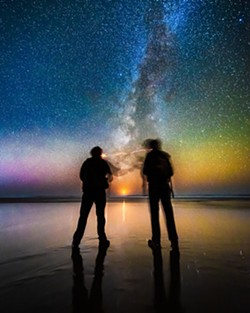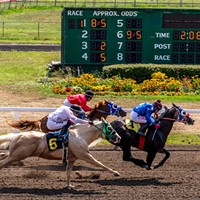
- David Wilson
- What passes between friends watching a crescent moon set into the Pacific at the bottom of the Milky Way? Nov. 11, 2018 on Moonstone Beach. How to get there: Take U.S. Highway 101 North toward Trinidad. Take exit 726A toward Westhaven Drive. Turn left onto Sea Drift Lane toward Moonstone Beach, then turn left onto Scenic Dr., then turn right onto Moonstone Beach Road.

Looking south from Tepona Point during the Perseid meteor shower, August of 2018. The bonfire of a group of Perseid meteor gazers blazed on the curve of Houda Point Beach, a beautifully warm counterpoint to the stars and planets above. How to get there: Take U.S. Highway 101 North toward Trinidad. Take exit 726A toward Westhaven Drive. Turn left onto Sea Drift Lane toward Moonstone Beach, then turn right onto Scenic Drive. Tepona Point is on the left.
Without the glare of city lights, starlight casts its soft glow on the landscape. In rural Humboldt County, the dark skies are filled with an unfathomable number of stars and a foray into the night need not take you far to see them.
As a rule of thumb, stargazing is best from the higher elevations of the hills, where the skies are more likely to be clearest. While there are also many good nights along the river valleys and beaches, there is more chance of fog or low cloud cover.
To see best under the stars, give your eyes time to adjust to the darkness. If you are fresh from the city, you may be amazed at the number of stars you can see. After 10 to 15 minutes, you will see more stars than when you began and within 25 or 30 minutes, the sky will be filled with points of light and you'll see more detail in your own surroundings. Avoid using bright flashlights, as that will ruin your night vision. If you can, find a headlamp or flashlight that gives you the option to use a red light; the red glow will give you light to see by while preserving your night vision. On a clear, moonless night, you might see well enough to walk about with no extra light.
Don't let the moon discourage you. Whether it is present or not, in whatever phase, it brings its own beauty. When the moon is in the sky it will certainly overcome some of the fainter stars but there will still be plenty. And as your eyes become accustomed to the darkness, the moonlight gives the landscape an otherworldly feel.
In late spring and summer, look for the Milky Way, the hazy band of stars stretching across the sky that comprises the densest region of our galaxy. Around mid-May its brightest region, the core of our galaxy, will be low on the southeastern horizon at around 11:45 p.m. By mid-June, it will be visible by 10:45 p.m. Each night through the summer, the core of the Milky Way rises higher earlier in the evening and creeps a little further south until after July, when it rises from the horizon in the southwest. The best part sinks away through fall and winter.
If you want to photograph the stars, remember the camera has some advantages over our human eyes when it comes to gathering light. The night will appear darker to you when you are out there than it does in these images. It's darker for us because our eyes only gather light moment by moment, which, in near darkness, simply doesn't allow enough time for much of an image to register on our retinas. To the camera, the same scene is brighter because it gathers light over an extended period of time, especially during long exposures. Additionally, increasing the light sensitivity of the sensor results in a brighter image with more detail in the sky and landscape than we see.
NOTE: If you travel outside of one of the many national or state parks, you may be venturing onto private property. Locals drive the rural roads, so always expect some traffic. Keep in mind there are animals in our area, including mountain lions and black bears. Information on wildlife safety can be found on the California Department of Fish and Wildlife website www.wildlife.ca.gov. If you are on one of the river banks, be aware that the currents are swift. If you find yourself at the ocean, be aware our wild and scenic beaches can have fierce undertows and sneaker waves. Consult a tide table and heed any signs that are posted. Wherever you go, please respect the land. Tread lightly to preserve the vegetation and pack out any items you brought.
To keep abreast of David Wilson's most current photography or peer into its past, follow him on Instagram at @david_wilson_mfx or visit his website mindscapefx.com.
Comments
Showing 1-1 of 1






